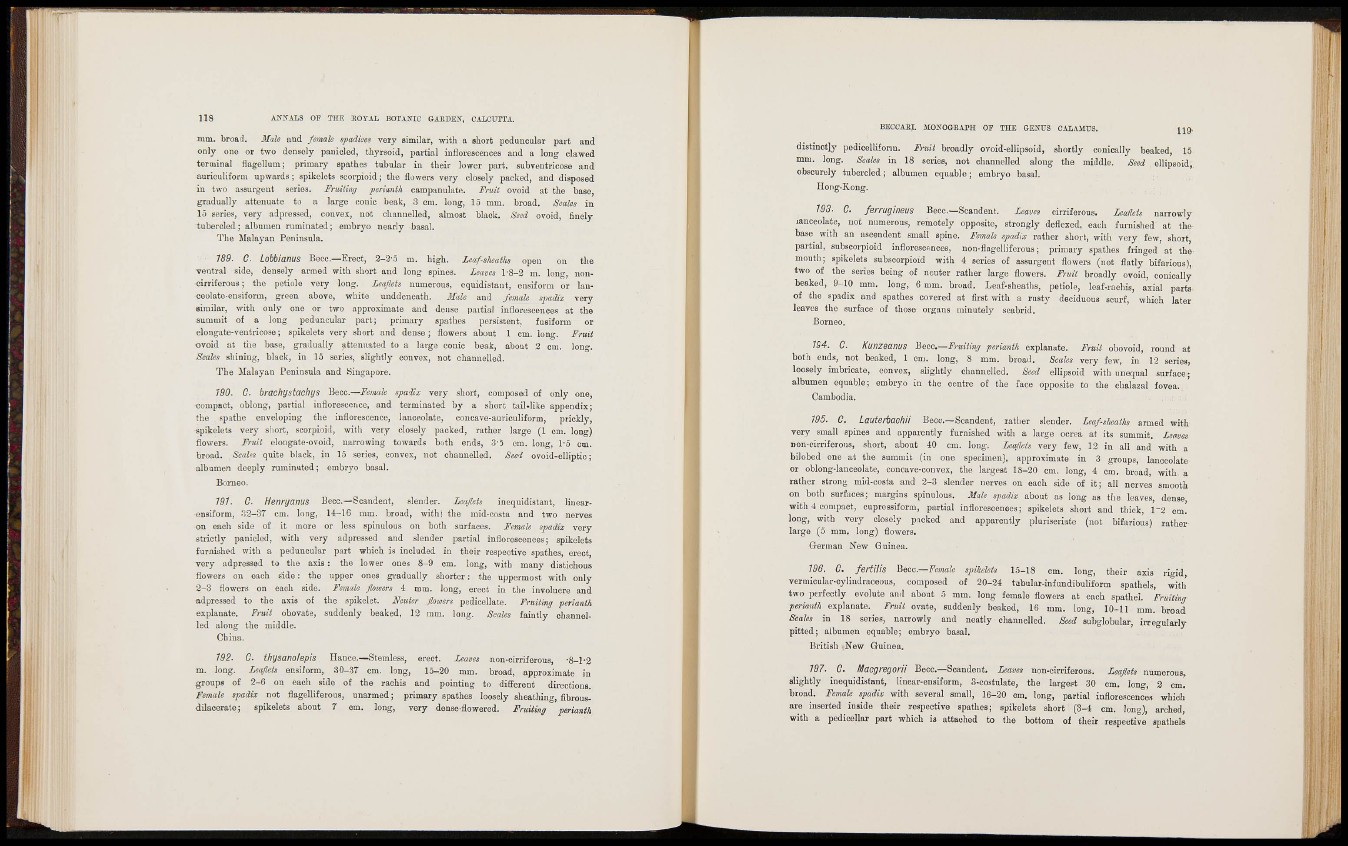
ns AJS'XALS OF THE HOrAL BOT.UÎIC GAJIDEN, CALCUTTA.
ram. broad. Male and female spadioes very similar, with a short pedancular part and
only one or two densely panicled, tliyrsoid, partial inflorescences and a loug clawed
terminal flagellum; primary epathes tubular in their lower part, subventricose and
auriculiforni upwards; spikelets scorpioid; the flowers very closely packed, and disposed
in two assurgeut series. Fruiting perianth campanulate. Fruit ovoid at the base,
gradually attenuate to a large conic beak, 3 cm. long, 15 mm. broad. Scales in
15 series, very adpressed, convex, not channelled, almost black. Seed ovoid, finely
tubercled; albmiien ruminated; embryo nearly basal.
The Malayan Peninsula.
189. C. Lobbianus Becc.—Erect, 2-2-Ô m. high. Leaf-sheaths open on the
ventral side, densely armed with short and long spines. Leaves 1-8-2 m. long, noncirriferous;
the petiole very long. Leaflets numerous, equidistaut, eusifovm or lanceolate
ensiform, green above, white unddeneath. Male and female spadix very
similar, with only one or two approximate and dense partial inflorescences at the
summit of a long peduncular part; primary spathes persistent. fusiform or
elongate-vontricose ; spikelets very short and don se ; flowers about 1 cm. long. Fruil
ovoid at the base, gradually attenuated to a large conic beak, about 2 cm. long.
Scales shining, black, in 15 series, slightly convex, not channelled.
The Malayan Peninsula and Singapore.
790. C. brachystachys Beoc.—Female spaiix very short, composed of only one,
compact, oblong, partial inflorescence, and terminated by a short tail-like appendix;
the spathe enveloping the inflorescence, lanceolate, concave-auriculiform, prickly,
spikelets very sliort, scorpioiii, with very closely packed, rather large (1 cm. long)
flowers. Fruit elongate-ovoid, nart'owing towards both ends, 3-5 cm. long, 1-5 cm.
broad. Scales quite black, in 15 series, convex, not channelled. Seed ovoid-elliptic;
albumen deeply ruminated; embryo basal.
Borneo.
757. C. Henry anus Becc.—Scandent, slender. Leajlek inequi distant, liuearensiform,
^2-37 cm. long, 14-16 ram. broad, withi the mid-costa and two nerves
on each side of it more or less spinulous on both surfaces. Female spadix very
strictly panicled, with very adpressed and slender partial inflorescences; spikelets
furniahed with a peduncular part which is included in their respective spathes, erect,
very adpressed to the axis : the lower ones 8-9 cm. long, with many distichous
flower.s on each side : the upper ones gradually shorter : the uppermost with only
2-3 flowers on each side. Female flowers 4 mm. long, erect in the involucre and
adpressed to the axis of the spikelet. Neuter flowers pedicellate. Fruiting •perianth
explanate. Fruit obovate, suddenly beaked, 12 mm. long. Scales faiutly channelled
along the middle.
China.
192. C. thysanolepis Hance.—Stemless, erect. Leaves non-cirriferous, -8-1-2
m. long. Leaflets ensiform, 30-37 cm. long, 15-20 mm. broad, approximate in
groups of 2-6 on each side of the rachis and pointing to different dii-ections.
Female spadix not flagellifevous, unarmed ; primary spathes loosely sheathing, fibrousdilacerate;
spikelets about 7 cm. long, very dense-flowered. Fruiting perianth
BECCAEI. IIONOGEAPH OF THE GENUS CAlAMUS. J^JQ,
distinctly pedicelliform. Fniit broadly ovoid-ellipsoid, shortly conically beaked, 15
mm. long. Scales in 18 series, not channelled along the middle. Seed ellipsoid,
obscurely tubercled; albumen equable; embryo basal.
Hong-Kong.
193. C. ferrugineus Becc.—Scandent. Leaves cirriferous. Leallets narrowly
lanceolate, not numerous, remotely opposite, strongly deflexed, eacli furnished at the
base with an ascendent small spine. Female spadix rather short, witl. very few, short,
partial, subscorpioid infloresc<^nces, non-flagelliferous; primary spathes fringed at the
mouth; spikelets subscorpioid with 4 series of assurgeut flowers (not flatly bifarious),
two of the series being of neuter rather large flowers. Fruil broadly ovoid, couically
beaked, 9-10 mm. long, 6 mm. broad. Leaf-sheaths, petiole, loaf-rachis, axial parts
of the spadix and spathes covered at first with a rusty deciduous scurf, which later
leaves the surface of those organs minutely scabrid.
Borneo.
154. 0. Kunzeanus Becc.—/'miV«^ perianth explanate. Fruil obovoid, round at
both ends, not beaked, 1 cm. long, S mm. broad. Scalcs very few, in 12 series,
loosely imbricate, convex, slightly channelled. Seed ellipsoid with unequal surface;
albumen equable; embryo in the centre of the face opposite to the chalazal fovea.
Cambodia.
195. C. Lauterbachii Becc.—Scandent, rather slender. Leaf-sheaihs armed with
very small spines and apparently furnished with a large ocrea at its summit. Leaves
non-cirriferous, short, about 40 cm. long, Leaflets very few, 12 in all and with a
bilobed one at the summit (in one specimen), ajjproximate in 3 groups, lanceolate
or oblong-lanceolate, concave-convex, the largest 18-20 cm. long, 4 cm. broad, with a
rather strong mid-costa and 2-3 slender nerves on each sido of it; all nerves smooth
on both surfaces; margins spinulous. Male spadix about as long as the leaves, dense
with 4 compact, cuprcssifonn, partial inflorescences; spikelets short and thick, 1-2 cm.
long, with vory closely packed and apparently pluriseriate (not bifarious) rather
large (5 mm. long) flowers.
German New Guinea.
196. C. fertilis Becc.—Femafo spikelets 15-18 cm. long, their axis rigid,
vermicular-cylindraceous, composed of 20-24 tnbular-infundibuliform spathels, with
two perfectly evolute and about 5 mm. long female flowers at each spathei. Fruiting
perianth explanate. Fruit ovate, suddenly beaked, 16 mm. long, 10-11 mm. broad
Scales in 18 series, narrowly and neatly channelled. Seed subglobular, irregularly
pitted; albumen equable; embryo basal.
British New Guinea.
197. C. MacgreyorU Becc.—Scandent. Leaves non-cirriferous. Leaflets numerous,
slightly incquidistant, Hnear-ensiform, S-costulate, the largest 30 cm. long, 2 cm.
broad. Female spadix with several small, 16-20 cm. long, partial inflorescences which
are inserted inside their respectivo spathes; spikelets short (3-4 cm. long), arched,
with a pedicellar part which is attached to the bottom of their respective spathelsllir
M